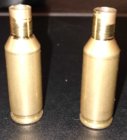Today for the first time I have needed to turn the necks on brass. I was having a hard bolt closure on once fired Lapua 6BR brass in my new home build. I troubleshot it down to the OD of the neck after seating was .269. I have had a Hornady neck turning tool sitting on the shelf for a year but this was the first time I have had the need for it. I was nervous as heck about cutting into the shoulder and figuring this was just a skim cut I stopped 1mm short of the neck. I would guesstimate about 50% to 75% of the neck area had brass removed. Loaded rounds chamber fine now and necks are a uniform .268 OD.
My question is will stopping the cut just short of the shoulder give me any problems down the road ?
My question is will stopping the cut just short of the shoulder give me any problems down the road ?











